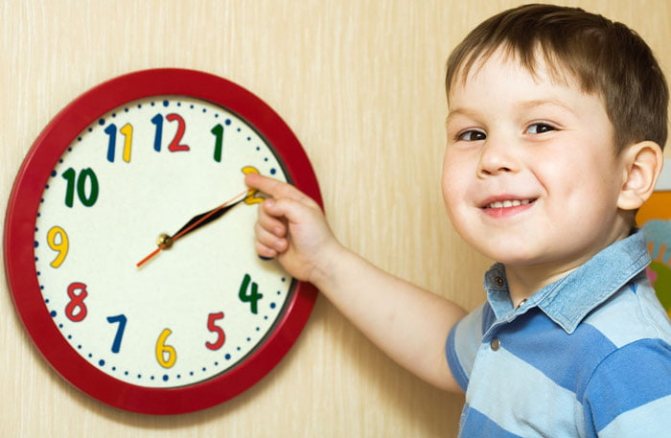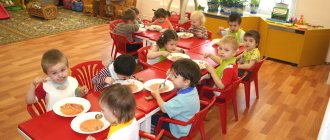The main components of the daily routine of children of different ages
The child’s daily routine should include the following mandatory elements:
- meal time. A child, depending on his age, must eat a certain number of times a day. The intervals between feedings are also important;
- time to sleep. The nervous system of a child, compared to an adult, is at the stage of formation, so exhaustion occurs faster, requiring recovery. Also, a small organism spends more energy on all vital processes than an adult. The need for sleep decreases as the child grows.
- time spent in the fresh air. It may include walking, sleeping, playing;
- time for compulsory educational activities. In a children's group and at home from a toddler age;
- free time. It becomes important when the baby already knows how to do something on his own. At this time, the child himself chooses his type of activity. Free time is important for processing received information and realizing creative abilities.
Approximate schedule
The daily routine of preschool children who go to kindergarten is subject to the work program of a particular institution. It might look something like this:
- 7:00 – 8:00 – getting up, exercising, morning hygiene, going to kindergarten;
- 8:00 – 8:30 - breakfast;
- 8:40 – 10:00 – gaming and educational activities;
- 10:10 – 12:10 – walk, games;
- 12:30 – 13:10 - dinner;
- 13:10 – 13:30 – preparation for daytime sleep;
- 13:30 – 15:30 - dream;
- 15:30 – 16:00 – awakening, quiet games;
- 16:00 – 16:30 – afternoon snack;
- 16:30 – 17:30 – educational activities, games;
- 17:30 – 19:00 – a walk, the way home, playing outside;
- 19:00 – 19:30 - dinner;
- 19:30 – 20:30 – quiet games;
- 20:30 – 21:00 – bathing, preparation for bed;
- 21:00 – 7:00 - night sleep.
The child spends the evening at home. Therefore, it is important for parents to remember that the child’s activities before bed should not be too noisy or active. You can read books, draw, play with blocks or construction sets, and discuss the past day.
If your preschooler attends kindergarten, try to adhere to the routine established at the preschool on weekends. This will allow the child to be more productive in activities by the beginning of the next week. If your child does not yet attend preschool, but you plan to send him there in the foreseeable future, find out the schedule of a particular kindergarten and teach your child to it while he is at home. Then it will be much easier for him to adapt to life in a children's group.
Are there any disadvantages to the daily routine?
The disadvantages of a daily routine, or, more precisely, objections to following a strict daily routine, are as follows:
- kids often get out of their usual routine, disrupting the sequence and timing of events. Their sleep and nutrition are easily disrupted by external factors (weather, physical or mental discomfort, changes in the type and method of feeding);
- children can intuitively follow their needs. This is the basis of the objection to forced obedience to a schedule;
- Strict adherence to the daily routine, ignoring individual living conditions, personality traits and age can lead to rigidity of thinking, inability to adapt to changes in the environment, deprivation of individuality and also to health problems.
How is a daily routine beneficial for a child?
The benefits of a routine are determined by physiological and psychological aspects, which are the basis for creating a daily routine:
- the benefit from the physiological side is the development of conditioned reflexes, with the help of which the body adapts to existing conditions. The child is prepared to perform the necessary tasks and does them without unnecessary stress. Those. energy is saved and distributed evenly for all necessary activities;
- from a psychological point of view, the child’s nervous system needs a stable environment, which, with its predictability, gives a feeling of peace and reliability. This, in turn, creates a favorable background for the child’s development, a deeper understanding of the actions performed and the development of skills.
How to accustom your baby to a routine?
To accustom your child to a routine, you need to follow the following simple recommendations:
- You can start accustoming your child to the regime after discharge from the maternity hospital. A parent needs to plan, first of all, his life, taking into account walks and meals. But be prepared that not everything will go smoothly right away. Most often, children enter the regime by 3 months.
- it is necessary to introduce some new stages gradually during complete health and at the moment of satisfaction from the fulfillment of urgent desires;
- it is necessary to take into account the age of the child, the nature of feeding, the time of year, state of health, personality characteristics;
- strive to maintain the regularity of events and their sequence;
- introduce rituals that prepare the child to perform a particular action. They facilitate the introduction of new components of the regime.
Home mode
What should you do if, for some reason, your child does not and will not attend kindergarten? Sticking to the same regime is a definite thing. True, with some nuances. The first of them is that the baby can be allowed to wake up a little later (since there will be no time needed to travel to the kindergarten). Secondly, you can also put the baby to bed later.
Another subtlety is that parents will have to organize educational activities for their child themselves. To do this, it is advisable to familiarize yourself with the requirements for preparing a child in the school that the child will attend in the future, and try to prepare the child in accordance with them. Of course, you can also attract specialists to help (for example, enroll your child in an early development group or with a teacher who will take on the role of a kind of tutor). But if you have confidence in your own abilities, then it is better if the parents teach the preschooler. This way they will have the opportunity to once again (which is not at all superfluous!) demonstrate to him their love, interest in his development and pride in his first achievements.
You will have to do the same things as in the garden: teach writing, reading, drawing, sculpting, dancing, teaching basic mathematical concepts, developing speech, studying nature, playing, developing the child physically (independently or in a sports section), and be sure to accustom him to work. Among other things, mothers are entirely responsible for their child’s diet.

Child's daily routine
A child’s daily routine depends primarily on his age.
Up to a year
When starting to talk about the regime of children under 1 year old, it would be correct to separately highlight the newborn period.
A newborn's daily routine consists of alternating periods of feeding and sleeping. Ideally, only hygienic procedures are wedged between them: washing, bathing, dressing.
Natural feeding
Natural feeding occurs at the request of the baby. This is important because the baby and mother adapt to each other during this period.
There are important points:
- It is impossible to limit the time spent at the baby’s breast, because The pace of sucking in babies is different and in the case of a slow “suckling”, with a reduction in feeding time, there is a risk of depriving him of his portion of “hind” milk, rich in protein and lactase. The result is weight loss, abdominal cramps, foamy stools with all the ensuing consequences. The average feeding time is 30-40 minutes (in hot climates, the baby can reduce the feeding time himself, consuming only foremilk, rich in water, and thus quenching his thirst). Valuable hind milk is produced approximately 20 minutes into feeding;
The mother should pay attention to the baby’s correct latching of the nipple so that during prolonged feeding the breast is not injured. Also, there is no need to dry out the skin of the areola with excessive washing and various antiseptics, because... This contributes to the formation of cracks and infection.
- Feeding by the hour during breastfeeding is a thing of the Soviet past, but you should pay attention to a baby that sleeps “too” well. It is advisable that regular sleep breaks between feedings should not exceed three hours. This is very important in the first month, because... Frequent feeding every 2-3 hours contributes to the good development of lactation in the mother, which, in turn, ensures the growth and development of the child and the prevention of mastitis in nursing mothers.
Night feedings must be mandatory, because... they stimulate the production of prolactin, which, in turn, supports daily lactation.
Therefore, if necessary, to comply with these conditions for successful feeding, it is sometimes necessary to even wake up the baby.
Feeding by the hour
When artificial feeding, it is necessary to adhere to feeding by the hour to avoid overfeeding, because... Formulas take longer to digest than breast milk.
The intervals between feedings are 2.5-3 hours, after 5 months - 4-4.5 hours.
Frequency of feedings: from 8 times a day in the first month and 5 meals by the year.
Age difference
The pattern of sleep and wakefulness in a newborn child differs from that of an older child due to a very short period of wakefulness. At this time, in addition to hygiene measures, the child can be given gymnastics and a light massage.
Time for walking and being outdoors
It coincides with sleep time. Once the newborn period has passed, the child's daily routine begins to change towards longer waking hours and shorter sleep times.
A child's waking time by month: at the age of 1-3 months, the total waking time is approximately 6-7 hours (the duration of a single period is 1-1.5 hours). From 3-6 months this time extends to 8.5 hours, while the child is in an active state for up to 2 hours. In the second half of the year, the daily waking time increases to 10 hours, with 2.5-3.5 hours in between sleep periods.
Approximate sleep schedule for a child up to one year: in the first half of the year, from the age of 1-2 months, a child can ideally sleep up to 3-4 times a day for 1.5-2 hours, in the second half of the year the frequency of sleep is 2 times 2.5-3 hours.
The outdoor routine for babies in the first months of life replaces sleeping on the street.
1 year old child's daily routine
“Yearlings,” despite the fact that they have successfully passed the age limit of 1 year, continue to follow the regimen of 9-10-month-old infants:
- night sleep - 10-11 hours;
- daytime sleep - 2 times for 2.5 hours;
Usually, by the age of one year, parents have an idea of what type their beloved child belongs to: a “night owl” or a “lark.” So, “owls,” that is, those children who like to get up closer to noon and go to bed by midnight, can sleep once a day.
- 5 meals a day;
- the period of total daily wakefulness is 10-11 hours;
- the period of stay in the fresh air can be up to 5-6 hours a day, depending on the time of year and weather conditions, but not less than 2 hours per day.
When organizing walks, it is necessary to provide for the child’s physical motor activity, as an important link in the development of physical and mental health.
Toddlers
For toddlers (1 year 6 months - 3 years), a regimen is built in such a way that it contributes to the proper development of the muscular and skeletal system, the development of speech function, strengthening the immune system, and improving existing basic motor skills. You need 4 meals a day, active walks in the fresh air at least twice a day for 2-3 hours.
There are classes devoted to the development of speech, self-care skills, and fine motor skills. They are carried out in a playful way. Children at this age can hold their attention for up to 10 minutes. These games are best played in the first half of the day, at least 30-40 minutes before rest. During the day, children over the age of one and a half years sleep, as a rule, once for 2-2.5 hours. The daily amount of sleep is 12-12.5 hours. The periods of wakefulness are approximately 4.5-5 hours.
If parents plan to send their child to kindergarten, then the daily routine should be as close as possible to the nursery routine. You should help your child in advance to adjust to waking up early and going to bed the same way in the evening if the child adhered to the opposite routine. Such an event will contribute to a faster and more successful adaptation to the life of the children's group.
Preschool children
The routines of preschool children vary by age. In kindergarten they are divided into groups.
| Groups | Age | Nutrition | Classes | Dream | Games | Walks |
| younger | 3-4 years | 4 times | 2 lessons of 10 min. morning and afternoon | 12-12.5 hours. Once a day for 2 hours | Before breakfast, after sleep and after afternoon snack | 2 times a day, at least 4 hours a day |
| average | 4-5 years | 4 times | 2 lessons in the morning for 10 minutes with a break of 10 minutes | 11.5-12 hours a day. 1 time during the day for 2 hours | Games in free time | 2 times a day, at least 4 hours a day |
| Older | 5-6 years | 4 times | 3 classes a day in the morning for 20 minutes with breaks of 10-12 minutes | 11.5-12 hours a day. 1 time during the day 1.5-2 hours | Games in free time | 2 times a day, at least 4 hours a day |
| Preparatory | 6-7 years | 4 times | 3 classes of 25-30 minutes a day before lunch with breaks of 10-12 minutes | 11.5 hours of night sleep, 1.5 hours of daytime sleep. | Games in free time | 2 times a day, at least 4 hours a day |
Thus, with age, the time spent practicing for the development of higher nervous activity increases, and the need for daytime sleep decreases.
Night sleep remains 10-11 hours long until the end of primary school.
The time for walks and games remains unchanged, which, as they grow older (from the age of 5 years), begins to include, and then become more complex, the main work activity (sweeping paths, cleaning the room, watering, etc.) lasting from 10 to 15 minutes a day.
Baby's daily routine - parents' work
If everything is more or less clear with feeding (you need to feed, you can’t overfeed), educational games are also in perfect order (young people start going to early development centers at the age of one and a half years), then such important components as proper sleep and physical activity in the fresh air are often omitted air. Namely, these two aspects provide a solid foundation for the development and health of the child.
To provide the child with adequate physical activity, the parent must:
- schedule time;
- overcome fear of weather and colds and try to walk with your child in any climatic conditions (with the exception of frost minus 15 (minus 20 for children over 5 years old) and wind over 15 m/s);
- choose clothes that will simultaneously protect from weather conditions and provide the child with the opportunity to actively move.
To ensure proper rest for the child’s nervous system (and the parent’s as well), you need:
- do not wait until the child goes to bed on his own (fatigue in children often manifests itself as overexcitement, which leads to motor and emotional disinhibition), but gently prepare the child for rest, taking into account the time required by age for wakefulness. To do this, you can introduce so-called rituals (certain sequential actions, quiet games, reading books, bathing, singing);
- exclude active types of games and gadgets before bedtime;
- provide adequate physical activity during the day so that the child does not become overtired or tired;
- try to ensure that going to bed and getting up in the morning are not too different on weekends and weekdays;
- try not to skip daytime sleep;
- avoid turning on the TV in the background during the day
- limiting the time spent using a computer and TV to 15 minutes a day for children over 3 years old.
What does it mean to be awake?
This is not just a period when the child does not sleep. The wakefulness of a preschooler attending kindergarten is filled with a variety of useful activities:
- walks (in winter - about 3 hours, in summer - up to 6);
- study of the surrounding world;
- physical activity;
- speech development classes;
- work activity;
- classes or games on mental development (mathematics, learning to read, logic, development of attention, memory), moral education;
- creative activity;
- music lessons;
- teaching writing skills.
Such activities directly contribute to the development of qualities that a child will definitely need at school: initiative, perseverance, concentration, activity, motor skills, curiosity, and the ability to withstand a certain amount of time at work.
For younger schoolchildren in kindergartens, up to 10 different classes are provided per week, for older students - up to 14.
At the same time, activities aimed at teaching children are planned between 9 and 12 o'clock in the morning, between 16 and 18 o'clock in the evening. This is due to the level of performance and activity of preschoolers during the day. The most unfavorable period for learning is between 12 and 16 hours.
When drawing up a lesson schedule, the degree of difficulty is also taken into account. The more complex ones include mathematics, speech development, studying the world around us, while the simpler ones include drawing, modeling, appliqué, and design. The most complex ones are planned in the first half of the week, when children are more productive, and the simple ones - in the second half. Static activities are combined with dynamic ones (walking, gymnastics, music classes).
Educational activities are structured taking into account age capabilities. The duration of one lesson for younger preschoolers is about 15 minutes (there should be no more than 2 per day), for older ones - up to half an hour (2-3 developmental classes are held daily).
Don't overdo the sections or circles. For a kindergarten-preschooler, 1–2 clubs are enough. He should have time to rest and communicate with his family. Excessive developmental workload will lead to overstrain of the nervous system, sleep disturbances, and a decrease in the body's immune defense.








